 || A Closer Look at The Earth
|| A Closer Look at The Earth


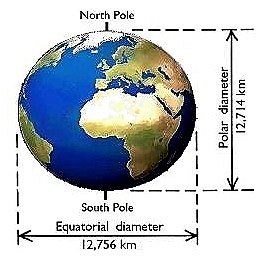
 Chimborazo, Ecuador. The Furthermost Point on the Earth's Surface from its Center.
Chimborazo, Ecuador. The Furthermost Point on the Earth's Surface from its Center.
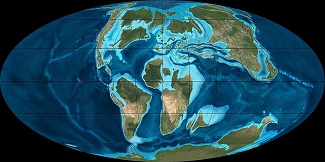 Pre-History Image of the Earth
Pre-History Image of the Earth
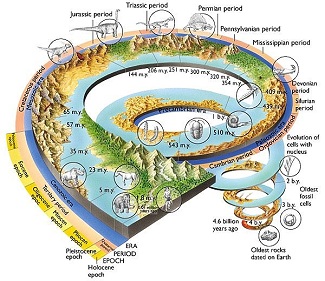
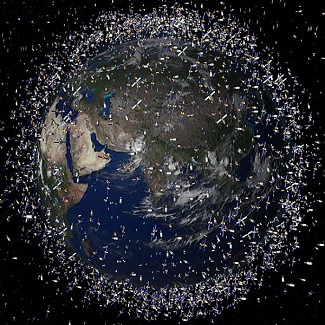 The Earth surrounded by Space Junk...
The Earth surrounded by Space Junk...
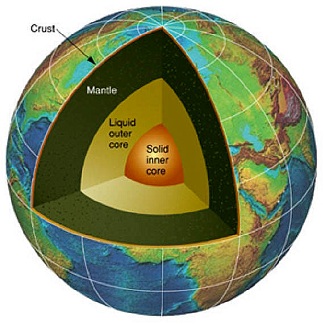
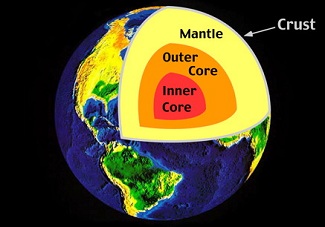
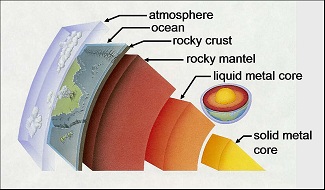
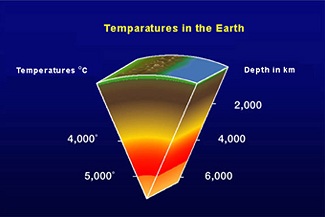
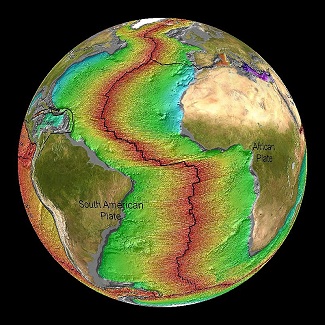

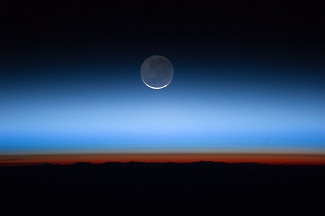 The Moon as seen from the International Space Station
The Moon as seen from the International Space Station
The Earth
Earth is the third Planet from the Sun, and the densest and Fifth-Largest of the Nine Planets in the Solar System.

Facts about the Earth:
The Shape of The Earth
The Shape of the Earth approximates an Oblate Spheroid, a Sphere flattened along the Axis from Pole to Pole such that there is a Bulge around the Equator.
This Bulge results from the Rotation of the Earth, and causes the Diameter at the Equator to be 42 km larger than the Pole-to-Pole Diameter.
For this Reason the Furthest Point on the Surface from the Earth's Center of Mass is the Chimborazo Volcano in Ecuador. The Average Diameter of the Reference Spheroid is about 12,742 km.
Local Topography Deviates from this Idealized Spheroid, although on a Global Scale, these Deviations are small: Earth has a Tolerance of about one part in about 584, or 0.17%, from the Reference Spheroid, which is less than the 0.22% tolerance allowed in Billiard Balls!
The Largest Local Deviations in the Rocky Surface of the Earth are Mount Everest (8848 m above local sea level) and the Mariana Trench (10,911 m below local sea level).
Because of the Equatorial Bulge, the Surface Locations Farthest from the Center of the Earth are the Summits of Mount Chimborazo in Ecuador and Huascarסn in Peru.
Because of the Axial Tilt of the Earth, the amount of Sunlight reaching any given Point on the Surface varies over the Course of the Year. This results in Seasonal Change in Climate, with Summer in the Northern Hemisphere occurring when the North Pole is pointing toward the Sun, and Winter taking place when the Pole is pointed away.
The angle of the Earth's Tilt is Relatively Stable over Long Periods of time. The Tilt does undergo Nutation; a Slight, Irregular Motion with a main Period of 18.6 years.
Obliquity of the Nine Planets

The History of Earth
Earth formed approximately 4.54 Billion Years ago by Accretion from the Solar Nebula, and Life appeared on its Surface within one Billion Years.
The Planet is home to Millions of Species, including Humans. Earth's Biosphere has significantly altered the Atmosphere and other Abiotic Conditions on the Planet, enabling the proliferation of Aerobic Organisms as well as the formation of the Ozone Layer, which together with Earth's Magnetic Field blocks harmful Solar Radiation, thus permitting formerly Ocean-confined Life to move safely to Land.
Estimates on how much longer the Planet will to be able to continue to Support Life range from 500 Million Years, to as long as 2.3 Billion Years.
Earth's Atmosphere and Oceans formed by Volcanic Activity and Outgassing that included Water Vapor. The Origin of the World's Oceans was condensation augmented by Water and Ice delivered by Asteroids, Proto-Planets, and Comets.
In this Model, Atmospheric "Greenhouse Gases" kept the Oceans from freezing while the newly forming Sun was only at 70% Luminosity. By 3.5 Billion Years Ago, the Earth's Magnetic field was established, which helped prevent the Atmosphere from being stripped away by the Solar Wind.
Earth's Crust is divided into several Rigid Segments, or Tectonic Plates, that migrate across the Surface over periods of many Millions of Years. About 71% of the Surface is covered by Salt Water Oceans, with the remainder consisting of Continents and Islands which together have many Lakes and other Sources of Water that contribute to the Hydrosphere.
The Planet's Interior remains Active, with a thick Layer of relatively Solid Mantle, a Liquid Outer Core that generates a Magnetic Field, and a Solid Iron Inner Core.
The Future of Earth
The Future of the Planet is closely tied to that of the Sun.
As a result of the Steady Accumulation of Helium at the Sun's Core, the Star's total Luminosity will Slowly Increase.
The Luminosity of the Sun will grow by 10% over the next 1.1 byr (Billion Years) and by 40% over the next 3.5 byr. Climate Models indicate that the Rise in Radiation reaching the Earth is likely to have dire Consequences, including the loss of the Planet's Oceans.
.
Earth Composition & Structure
Earth is a Terrestrial Planet, meaning that it is a Rocky Body, rather than a Gas Giant like Jupiter.
It is the Largest of the Four Solar Terrestrial Planets in Size and Mass. Of these Four Planets, Earth also has the Highest Density, the Highest Surface Gravity, the Strongest Magnetic Field, and Fastest Rotation, and is probably the only one with Active Plate Tectonics.
The Interior of the Earth, like that of the other Terrestrial Planets, is divided into Layers by their Chemical or Physical (rheological) Properties, but unlike the other Terrestrial Planets, it has a distinct outer and inner core.
The Outer Layer of the Earth is a Chemically Distinct Silicate Solid Crust, which is underlain by a Highly Viscous Solid Mantle. The Crust is separated from the Mantle by the Mohorovicic Discontinuity, and the thickness of the Crust varies: Averaging 6 km under the Oceans and 30-50 km on the Continents.
The Crust and the Cold, Rigid, top of the Upper Mantle are collectively known as the Lithosphere, and it is of the Lithosphere that the Tectonic Plates are comprised. Beneath the Lithosphere is the Asthenosphere, a relatively Low-Viscosity Layer on which the Lithosphere rides.
Important changes in Crystal Structure within the Mantle occur at 410 and 660 km below the Surface, spanning a Transition Zone that separates the Upper and Lower Mantle.
Beneath the Mantle, an Extremely Low Viscosity Liquid Outer Core lies above a Solid Inner Core. The Inner Core may rotate at a slightly higher Angular Velocity than the remainder of the planet, advancing by 0.1-0.5° per Year.
Earth Inner Structure:
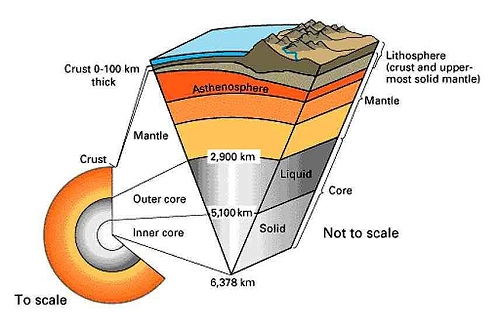
Tectonic Plates
The Mechanically rigid outer layer of the Earth, the Lithosphere, is broken into pieces called Tectonic Plates.
These plates are rigid Segments that move in relation to one another at one of three types of Plate Boundaries:
Convergent boundaries, at which two plates come together,
Divergent boundaries, at which two plates are pulled apart,
Transform boundaries, in which two plates slide past one another laterally.
Earthquakes, Volcanic Activity, Mountain-building, and Oceanic Trench Formation can occur along these Plate Boundaries. The Tectonic Plates ride on top of the Asthenosphere, the Solid but Less-Viscous part of the Upper Mantle that can flow and move along with the Plates, and their motion is strongly coupled with Convection Patterns inside the Earth's Mantle.
Earth's Main Plates:
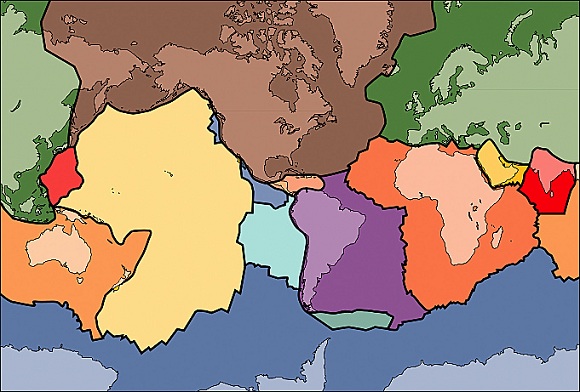
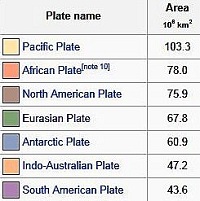
A Beautiful View of the Planet Earth at Night


